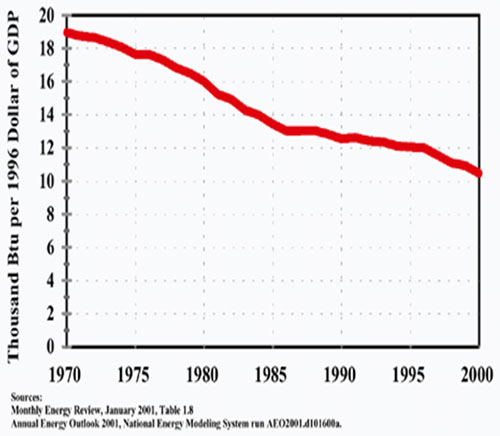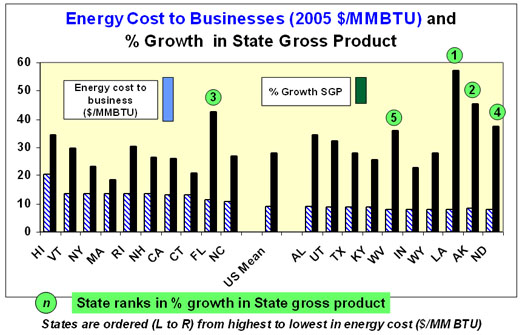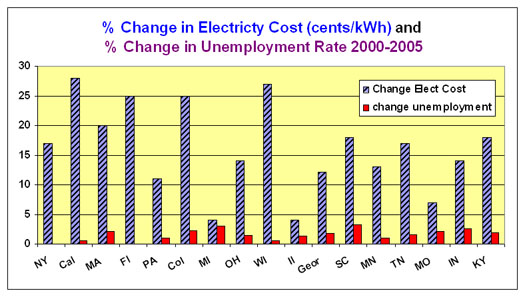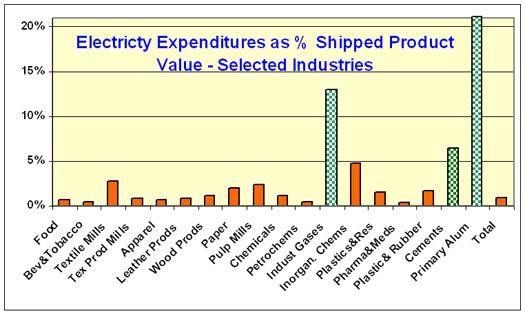Do Electric Costs Drive the Economy?
Location: New York
Author:
Bob Bellemare and Dr. Bernie Neenan
Date: Tuesday, March 27, 2007
Electric rates for many utilities are on the rise once again, raising the question, "What are the potential impacts of increased electric costs on the economy?" Many in the utility industry would likely think the impact is potentially large, but recent data suggests electricity costs and the overall economy are not as directly linked as they once were. Instead, concerns should focus upon the potential disproportionate impact on the budgets of low income customers and the possible impacts on key industrial accounts and the few commercial segments where electricity remains a key component of business operations.
Electricity Costs and the Overall Economy
The theory is that higher electricity costs will eventually trickle through the economy, leading to higher prices for goods, which in turn reduces product demand. The drop in product demand eventually leads to higher unemployment and, therefore, a negative impact on the overall economy. While certainly this can be true to some degree, when looking at available data, it does not appear electricity costs are having the magnitude of impact on the economy that they once did.
One important factor is that energy consumption is a smaller portion of the economy than it once was. As the Energy Information Administration (EIA) statistics show, energy consumption per Gross Domestic Produce (GDP) has been nearly halved since 1970.
Energy Consumption Per Dollar of
Gross Domestic Product (source EIA)

When looking at business energy costs and state gross product growth rates, there does not appear to be a strong tie between these factors. In the following chart, energy costs are normalized on a dollar per million BTU basis ($/MMBTu) and are graphed with a striped bar. 2005 energy costs are then compared to the growth rate in state gross product (solid bars) over the 2000 to 2005 period. While four of the top five states with the highest growth rates also have some of the lowest cost energy prices in the United States, the graph shows that some states with very high energy prices also have strong growth rates. Consider Hawaii: it had more than double the energy costs of many low energy cost states, yet their growth rate was over 30 percent in the five year period. Florida, while ranking ninth highest in business energy costs was third in overall economic growth.

When the five year percent change in electricity rates are compared to the percent change in unemployment rate, the correlation between costs and unemployment becomes even more tenuous. Notice that New York, California, Florida, and Wisconsin have some of the largest changes in electricity costs, yet their change in the unemployment rate is negligible.

Chart Source: Americans for Balanced energy Choices. November 2006. Impact of Increased Energy Costs on Business and Jobs.
There are several other data sets that were examined that demonstrated the same trend of electricity and energy costs losing their grip on the overall economy. More analysis is clearly needed before drawing firm conclusions, but recent data suggests that as energy and electricity intensive industries have declined and overall energy efficiency has improved in the United States, so too has the impact of energy/electricity costs on the overall economy.
While electricity costs may be losing their grip on the overall economy, there remain industries such as industrial gases, aluminum, plastics, and cement industries that are very electricity and energy intensive. However, several of these industries have experienced strong price and demand growth in their own markets, so in many instances it could well be that end-product prices are keeping pace or are increasing faster than their electricity costs.

Source: EIA
Residential customers will certainly feel the direct result of rate increases, and the level of impact may not be so evenly spread. According to EIA REC's survey year 2001 data, a residential customer making less than $10,000 per year averages more than six percent ($600) of their income being spent on electricity. By contrast, those making over $50,000 per year spend about 2.4 percent ($1200) of their income on electricity. If residential electric rates were to rise, say by thirty percent, then it is the low income resident whose budget gets a higher proportion impact. With a 30 percent rate increase, electricity costs for the low income would jump to 7.8 percent of income compared to 3.1 percent for the over $50,000 income group. Utilities and policymakers must therefore carefully consider how to “distribute the pain” of rate increase. Some may choose, for example, to subsidize rates for lower income customers. Of course this comes at a consequence of introducing another price distortion into the economy by not charging customers what it truly costs to serve them.
Electric rates in many states are seeing double digit rate increases caused by numerous factors impacting the industry. These factors include rising fuel costs, investment in emission controls, the increasing cost of basic commodities used in the industry (concrete, steel, wood, aluminum), and the need for new baseload generation resources. While these rate increases will certainly trickle through the economy, the silver lining in the cloud could well be that the impacts may not be as severe as in years past. Certainly more analysis is required before drawing hard conclusions, but an initial look at data suggests electricity costs and the overall economy are not as closely tied as in the past. Perhaps the policy changes from the past (PURPA, appliance standards) and the migration from a manufacturing to a services economy have helped reduce the impact from increasing energy costs on the general economy.
UtiliPoint's IssueAlert® articles are compiled based on the independent analysis of UtiliPoint consultants. The opinions expressed in UtiliPoint's® IssueAlert® articles are not intended to predict financial performance of companies discussed, or to be the basis for investment decisions of any kind. UtiliPoint's sole purpose in publishing its IssueAlert articles is to offer an independent perspective regarding the key events occurring in the energy industry, based on its long-standing reputation as an expert on energy issues.© 2007, UtiliPoint® International, Inc. All rights reserved. This article is protected by United States copyright and other intellectual property laws and may not be reproduced, rewritten, distributed, redisseminated, transmitted, displayed, published or broadcast, directly or indirectly, in any medium without the prior written permission of UtiliPoint® International, Inc.

To subscribe or visit go to: http://www.riskcenter.com